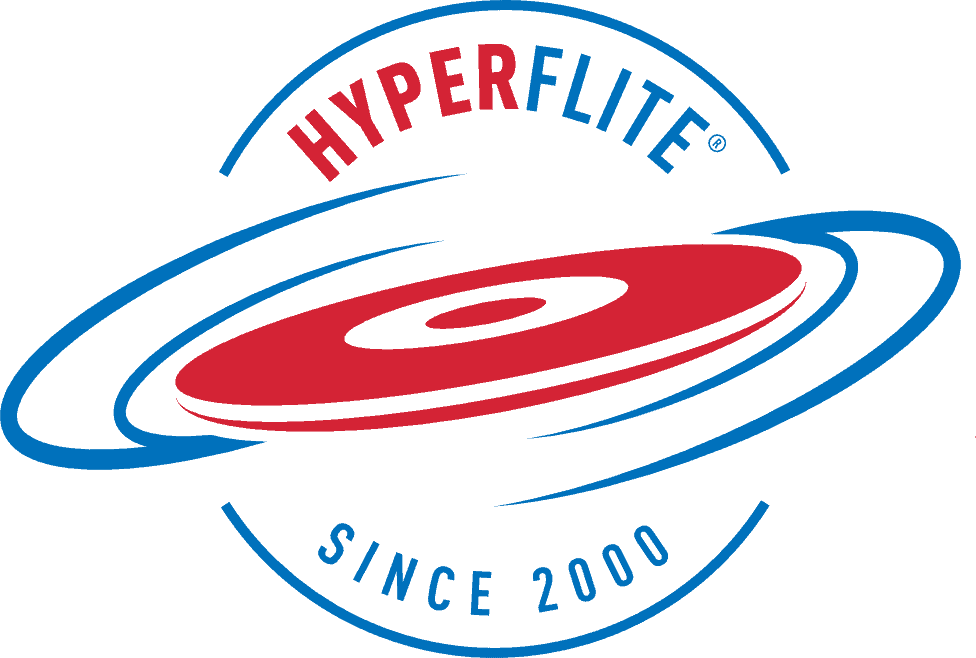The Story Behind X-Flash Anti-Glare Technology
The latest Hyperflite innovation, known as X-Flash™ technology, was the product of several years of hard work and experimentation. But, it might not have happened at all were it not for a happy coincidence. In essence, the discovery of the “sunflash” phenomenon (more about that later), which ultimately resulted in the development of X-Flash™ technology, was a bit like the proverbial Newton’s Apple. But before Sir Isaac Newton was bonked on his noggin by a “Granny Smith,” thousands before him were likely similarly thumped. They just didn’t put two and two together. Fortunately, when the apple finally fell on Hyperflite Co-founder, Jeff Perry, he, like Newton, knew what to do with it.
Here’s how it happened. A few years ago, while sitting in the judges chair, for yet another round of Freestyle, Perry observed a white flash of reflected sunlight emanate from the surface of a flying disc an instant before the competing canine could snatch it from the air. The canine had zeroed in on the disc and was in a perfect position to make the grab. However, not only did the canine miss the disc, he missed the next few discs as well. In fact, the next couple of tosses practically hit the dog in the face, though he appeared to not even see them. Perry later recalled that the proverbial “light bulb” literally flashed on in his brain. Perry wondered to himself, “how could I have missed this?” And he began to watch carefully for what he termed “sunflashes” for the remainder of the competition. He was surprised at how many times that the discs used in the competition “popped” like flash bulbs as they flew through the air.
Like the Bulldog breed that he loves so much, Perry refused to let go of the notion that maybe…just maybe…these sunflashes were responsible for more than a few missed catches. So he began to experiment. Since all the discs made by canine disc manufacturers have glossy surfaces, the sunflash phenomenon was easy to repeat with any manufacturer’s disc. Perry blinded himself, in his words, “about a thousand times,” during his research. He learned that the closer the disc is to your face, when you experience a sunflash, the more likely it is that you will be temporarily sun-blinded. He also learned that “sun artifacts,” that is, images of the sun that seem to be burned into your retina, can stay with a human for ten seconds or more when said human gets a face full of sunflash. He felt sure that dogs would experience these “sun artifacts” as well.
Perry also poured over hundreds of hours of video watching for sunflashes. Naturally, Perry extended his research to the field of canine eyesight and learned that dogs, by virtue of their larger lenses and pupils, are much more efficient light gatherers than humans. Canines excel in low-light conditions because they are such efficient light gatherers. But, Perry notes that “to get one thing, you always have to give something else up.” According to Perry, experts in canine vision observe that a dog’s near vision is less acute than human vision as a consequence of the dog’s superior vision in low light conditions. To put it another way, dogs can track an object well, at great distances, but lose accuracy as they get very close to an object. Couple poorer canine near vision with a “face full of sunflash,” an instant before a catch needs to be made, and you have identified the disc dog’s Achilles heel.
Once Perry confirmed the existence of sunflash, finding a cure for the problem was his next task. Needed, was an exceptionally non-reflective surface that would scatter and diffuse sunlight at a disc surface before it could be reflected back toward a pursuing canine. First, Perry painted a disc with a flat paint. The flat paint did a decent job of diminishing the sun’s reflectivity, but a painted disc wasn’t a very permanent, or safe, solution for a disc that would be caught in the mouth of man’s best friend. Acid baths, disc decals and in-mold decorating offered possible solutions, but they were deemed unsafe or too costly. So Perry began experimenting with special frosted textures that could be incorporated into Hyperflite’s canine disc molds. The perfect texture would need to scatter enough sunlight to essentially kill the sunflash at the surface of the disc. The texture also had to be exceptionally smooth so as not to cause wear to canine teeth. After much experimentation, Perry found the surface coating he was looking for and named it X-Flash™.
After applying for a patent on the X-Flash™ technology, Hyperflite moved immediately to incorporate X-Flash™ into all of its canine disc molds. And, just like that, a “stealth problem” faced by every disc dog team since the inception of canine disc sports, was banished before anyone even realized that a problem existed.
A little “revolution,” now and then, is a good thing!
